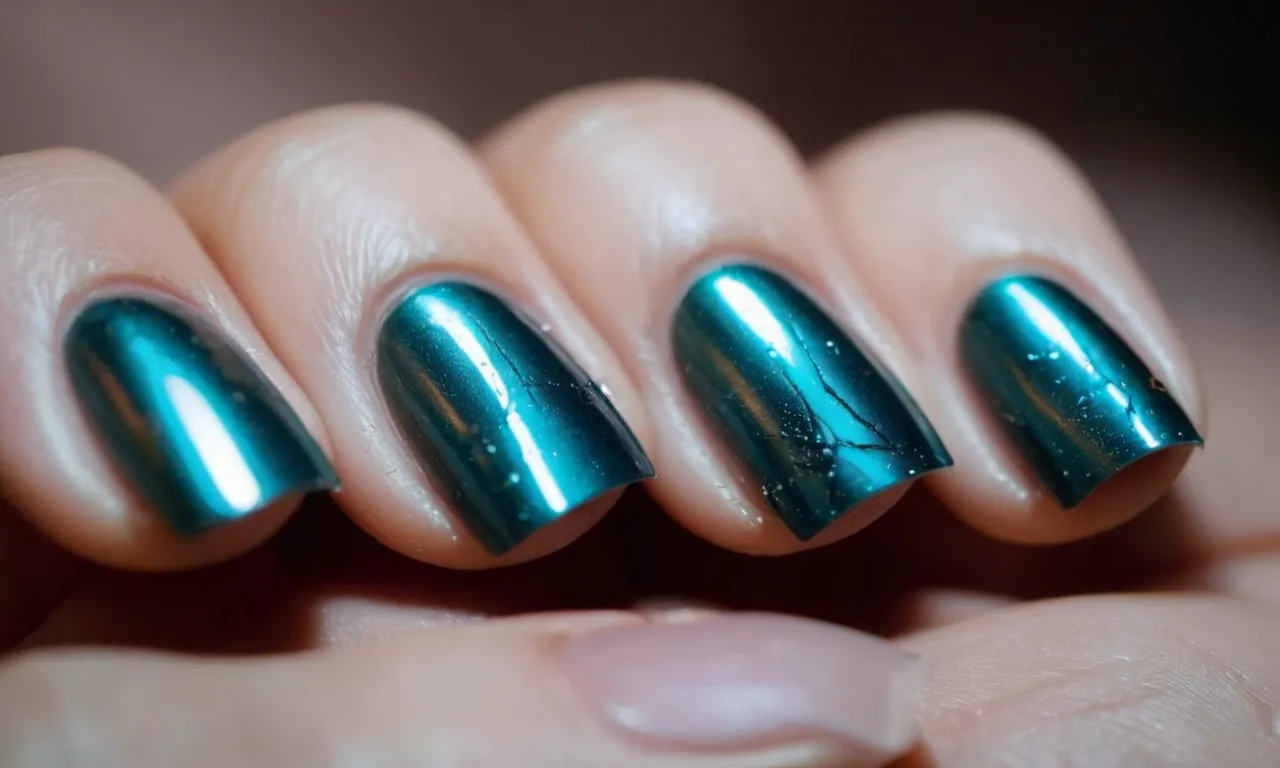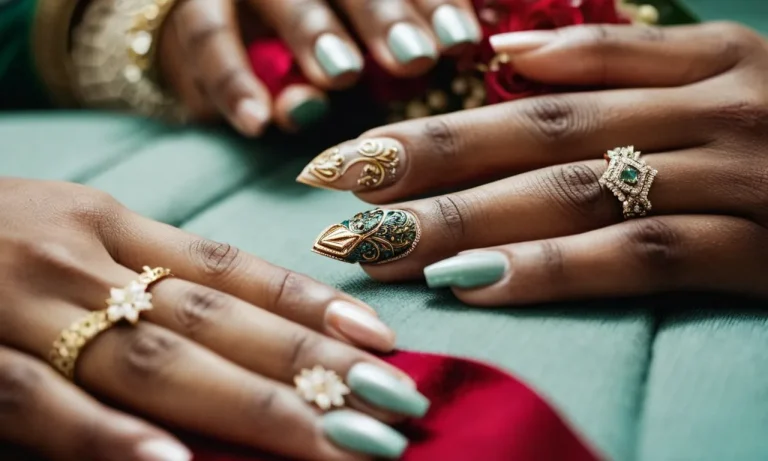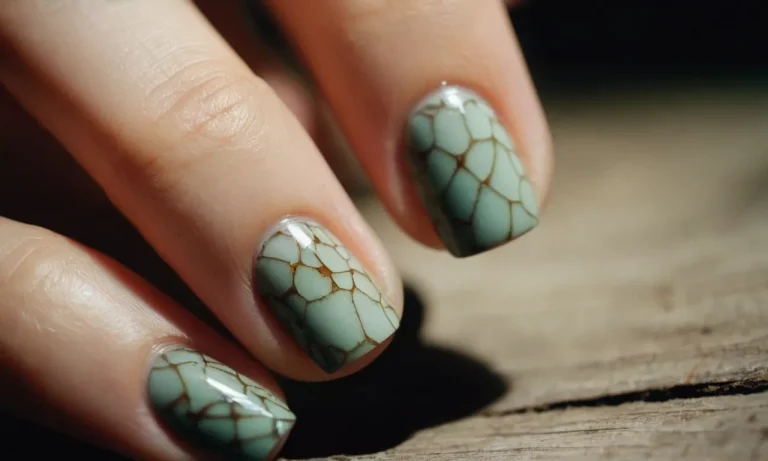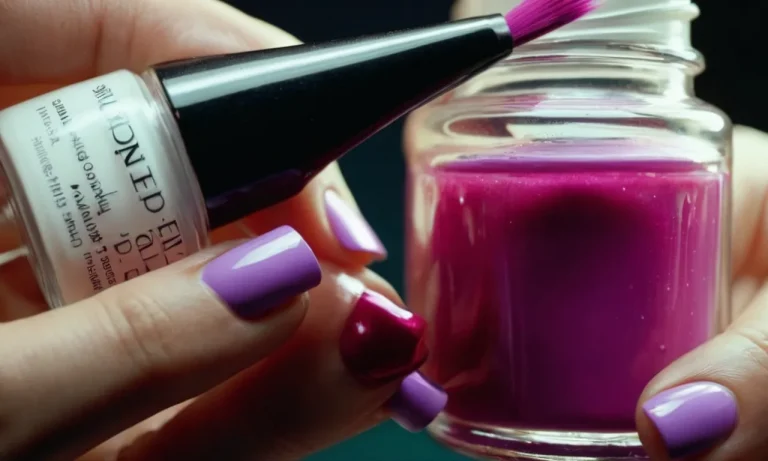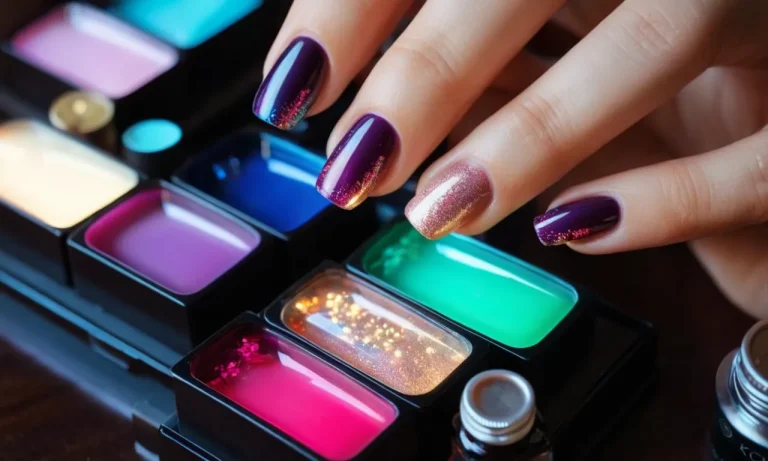Does Nail Polish Damage Nails? The Pros And Cons
With so many fun nail polish colors and designs to choose from, it’s easy to change up your manicure on a regular basis. But some people wonder if frequently painting their nails can be damaging over time.
Here’s a quick answer: Using nail polish does not inherently damage healthy nails, but certain types of polish, chemicals, and removal techniques could potentially weaken nails if used excessively.
In this comprehensive guide, we’ll look at the effects of nail polish on nail health. We’ll cover the pros and cons of using nail polish, best practices to avoid damage, and tips for keeping your nails healthy with or without polish.
How Nail Polish Interacts with Nails
Nail polish forms a protective barrier on the surface of nails that can have both benefits and drawbacks. Here’s an overview of how nail polish interacts with natural nails:
Nail polish forms a protective barrier
Applying a fresh coat of nail polish creates a plastic-like film over the nail plate. This may help prevent nails from becoming damaged by contact with water or other chemicals. The lacquer also provides a smooth, even appearance that some people find more aesthetically pleasing than bare nails.
Ingredients like formaldehyde can be harmful
Some nail polishes contain controversial ingredients like formaldehyde, dibutyl phthalate (DBP), and toluene. There are concerns that small amounts of these chemicals can be absorbed through the nail plate over time.
Formaldehyde is a known human carcinogen, and DBP and toluene have been linked to other health issues. However, many major nail polish brands have reformulated to remove these ingredients.
Acetone remover dries out nails
Acetone-based nail polish remover works by breaking down the nail polish and dissolving it from the nail surface. However, this process can cause dryness and irritation. Acetone is a harsh solvent that strips away oils from the nail plate.
With repeated use, this can leave nails feeling brittle and dry. Using remover sparingly and moisturizing after taking off polish can help counteract this drying effect.
Pros of Using Nail Polish
Protects nails from damage
Applying nail polish creates a protective barrier over the nail plate that shields it from the elements. The lacquers contain chemicals like formaldehyde, toluene, and dibutyl phthalate which harden into a plastic-like coating adhering to the keratin surface of the nails.
This guards your nails against chipping, cracking, and peeling caused by exposure or trauma (American Academy of Dermatology).
Additionally, certain nail polish products are enriched with vitamins, minerals, and proteins that condition the nails. For instance, some formulas contain biotin, calcium, and keratin which strengthen nails making them less prone to breakage or splits.
Vitamin E and oils may also be added to nourish the nail bed for improved growth and flexibility.
Allows you to express yourself
Nail polish provides a simple yet effective means of enhancing your personal style. The color, texture, and effects allow you to communicate your personality whether it’s bold, creative, edgy or understated. It’s an accessible way to showcase your individuality.
The variety of shades, finishes like cremes, shimmers, and glitters give you limitless options for self-expression. Nail art using polish allows you to get even more creative. Even the shape and length of your manicure sends a message.
So polish can be played with to suit your ever-evolving moods and tastes.
Covers up imperfections
Minor flaws on nails like discoloration spots, grooves, or ridges can make you self-conscious about showing bare nails. Nail polish is a quick fix to mask such blemishes so your nails look smoother and more uniform.
Most polishes provide opacity to fully hide imperfections on the nails. Certain filling ridge polishes are designed specifically for smoothing over ragged edges and grooves by filling them in.
Salon gel manicures are especially effective at concealing flaws because they are applied thicker on the nail. The hygienic seals they form hide even very bad nails from view.
Cons of Using Nail Polish
Can damage nails if picked off
One of the biggest cons of using nail polish is that it can actually damage your nails if you have the habit of picking or peeling it off. The constant picking and peeling can weaken your nails and thin them over time.
Dermatologists say the biggest culprit is peeling off gel manicures before they are properly soaked off. Trying to scratch or rip off the gel can pull layers of your actual nail off with it, leading to peeling, splitting, and breakage.
Regular nail polish can damage nails too if you pick at it before it fully dries or peel it off before applying a remover. Picking off wet polish takes layers of your nail with it. Even peeling off dried polish can slowly thin out your nails. The pulling motion strains the nail layers underneath.
The best practice is to use acetone remover to take off polish and gel manicures and avoid scratching, picking or peeling. If you currently have this habit, try to resist the urge and be patient with proper remover to avoid nail damage.
Frequent remover use dries nails
Using nail polish remover too often can lead to dry, brittle nails over time. Most removers contain fairly harsh chemicals like acetone or ethyl acetate that are effective at breaking down polish but are very drying to natural nails.
Frequent use of nail polish remover strips away natural oils and moisture from your nails. The acetone in removers works as a solvent that breaks the bonds of nail polish, but it also dehydrates the nails in the process. This can leave nails feeling dry and fragile.
Those who change polish multiple times a week or get regular gel manicures may notice their nails becoming thin and peel-prone if they are not taking preventative measures. Using nourishing cuticle oil around the nails between polish applications can help replenish moisture.
You can also apply a hydrating nail strengthener underneath color coats.
When possible, allow 2-3 days between polish changes to give nails a breather. Alternate using remover with giving nails a week off from polish here and there. The less frequent exposure to drying chemicals, the better.
Dark colors may stain nails
Though beautiful, darker nail polish shades like black, blues, greens and purples have a reputation for staining nails with continued use. These deep pigments contain staining ingredients like iron oxides that can penetrate the nail plate and become trapped within the layers.
The result is that nails may appear stained or discolored, with a yellowish, greenish or greyish tint after removing especially dark polishes. The iron oxide pigments bind to keratin fibers in the nail and cannot be fully washed away.
This is more prominent in people with thinner or more porous nail plates.
However, there are ways to prevent or minimize staining. Using a base coat underneath dark polishes can create a protective barrier. Applying a stain-removing ingredient like lemon juice or whitening toothpaste directly to stained nails for 5 minutes before rinsing can help draw out some of the discoloration.
Taking occasional breaks by wearing lighter colors or going polish-free for a few days gives nails time to breathe and restore their natural color. Using nail strengtheners or hardeners can also help fill in porous nails and limit how deeply pigments penetrate.
Best Practices for Healthy Nails
Use non-toxic and ‘3-free’ polish
When choosing a nail polish, look for brands labeled as “non-toxic” or “3-free“. These products do not contain the “toxic trio” of chemicals – formaldehyde, toluene, and dibutyl phthalate (DBP) – which can weaken and damage nails over time with repeated use (1).
Instead, 3-free polishes use safer alternative ingredients.
Water-based nail polishes labeled “eco-friendly” or “vegan” also tend to exclude these harsh chemicals. Popular natural nail polish brands like Zoya and Obsessive Compulsive Cosmetics (OCC) offer extensive non-toxic color ranges (2).
Let nails breathe between manicures
As tempting as it might be to constantly keep your nails polished, allowing some breaks between manicures gives your nails time to breathe and recover. The American Academy of Dermatology Association recommends leaving nails bare for several days before your next application (3).
Try to go polish-free for at least a week out of every month. Or, alternate between light nudes and bolder shades rather than constantly wearing dark lacquers, which block out more air and light from reaching the nails.
Be gentle when removing polish
Aggressively scraping off old lacquer can thin and weaken nail beds. Instead, gently remove polish with a natural dissolving product. Look for plant-based acetone-free formulas with moisturizing oils to avoid dryness and breakage.
Soak cotton pads in remover liquid, then hold them against each nail for 30 seconds before gently sliding the polish off. Repeat if needed while being careful not to scrape too hard near the cuticles.
Hydrate nails and cuticles
Just like skin, nails and cuticles need moisture to stay supple and prevent cracking. Work a nourishing cuticle oil around and under the nails daily. Look for ones containing vitamins and botanical oils like jojoba, coconut, and vitamin E. Massage it in gently using small circular motions (4).
For an intensive weekly treatment, apply a thick hydrating cream or mask meant specifically for cuticles and nails. Some products come with plastic fingertips to lock in moisture. Wear them overnight for maximum benefit.
Caring for Bare Nails
Moisturize nails daily
Keeping your bare nails moisturized is key to maintaining strong, healthy nails. When nails are dry, they become brittle and prone to peeling, cracking and breakage. Experts recommend massaging a nourishing nail oil, cream or butter into the nails and cuticles at least once daily.
Look for moisturizers formulated with hydrating ingredients like vitamin E, jojoba oil, shea butter and glycerin. Massage the product into nails in a downward motion until fully absorbed. This simple routine helps seal in moisture and prevent water loss (1).
Proper filing technique
Regularly filing nails is important for shaping and smoothing edges, but improper technique can lead to more harm than good. Always file nails when dry, using gentle, downward strokes in one direction. Sawing back and forth can weaken nails.
Opt for a high-quality emery board and discard once it feels rough or gritty, as worn boards can damage nails (2). Avoid using metal nail files, as they can severely wear down the nail plate. After filing, buff nails in a sideways motion to smooth and seal the keratin layers (3).
This helps strengthen nails and prevent peeling and splitting.
Avoid excessive water exposure
Frequent, prolonged water exposure is one of the worst offenders for bare nails. Water, especially hot water, can deplete natural moisture from the nail plate, leading to dryness and brittleness. Wearing gloves during dish washing, cleaning and other wet tasks helps shield nails.
After hand washing, thoroughly dry nails to prevent water logging. A 2017 study found that soaking nails in olive oil before and after water exposure preserved nail hydration and flexibility better than commercial moisturizers (4).
Consider carrying a small bottle of oil to combat day-to-day water damage.
Other Tips
- Wear rubber gloves during housework and gardening
- Avoid very hot showers and limit time in the bath
- Use a nail strengthener or hardener if prone to peeling/splitting
- Don’t pick at nails to avoid tear and damage
- Trim nails regularly to prevent snagging and breakage
With some diligent nurturing, your natural nails can thrive beautifully. Consistent moisture, gentle filing and limiting water exposure helps keep bare nails in top shape. Who needs a manicure when a little TLC at home works wonders?
Conclusion
While nail polish won’t necessarily damage healthy nails on its own, certain chemicals, removal methods, and excessive use can weaken nails over time. Using non-toxic polish and giving nails a break between manicures allows you to paint them frequently while maintaining strength.
And caring for bare nails by keeping them hydrated and protected is key for nail health with or without color.

